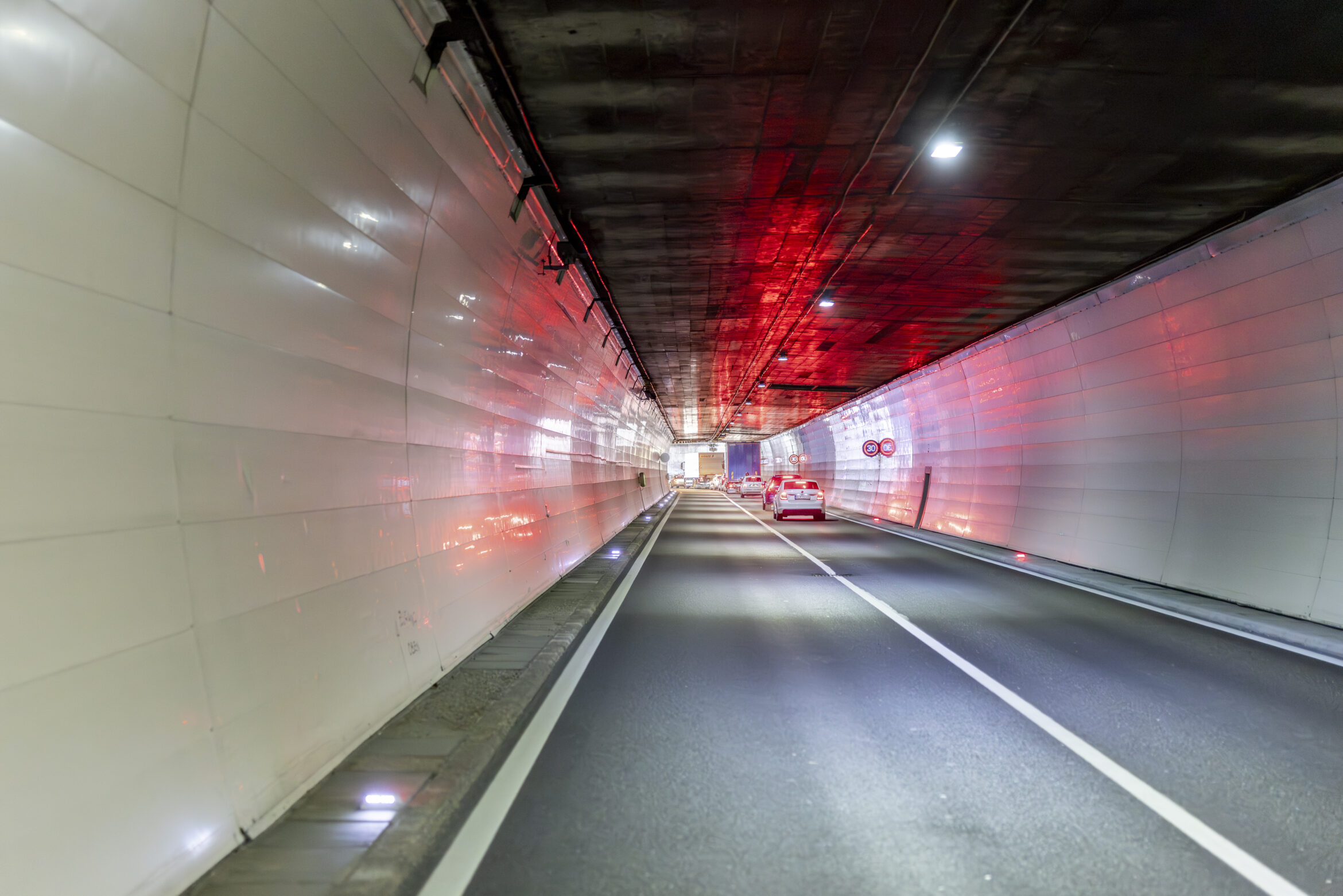Tunnel Safety

What to do in the event of an accident in a tunnel
Breakdown or accident:
- Switch on hazard warning lights.
- Park vehicle on hard shoulder, in breakdown bay, or on right-hand side of road.
- Put on high-visibility vest.
- In the event of breakdowns and accidents outside the breakdown bay, secure vehicle using warning triangle.
- Turn off the engine and leave the key in the ignition.
- Use the emergency call systems (telephone, “SOS” or “Fire” button) – this will automatically locate the emergency call.
- Administer first aid.
Fire:
- Switch on your hazard warning lights.
- If your vehicle is on fire: If possible, park on the hard shoulder, in a breakdown bay or on the right-hand side of the road so that the emergency services are not obstructed.
- Turn off the engine, leave the key in the ignition, and leave the vehicle immediately.
- If possible, extinguish the fire in its early stages using the fire extinguishers and hose reels available in the tunnel.
- Administer first aid.
- Use emergency call systems (telephone, “SOS” or “Fire” buttons) – this will automatically locate the emergency call.
Caution:
In the event of a truck accident involving hazardous materials, the numbers on the corresponding warning signs should be reported to the fire department immediately.
- Help others to reach a safe place together.
- In the event of heavy smoke, leave the tunnel immediately via the escape routes and follow the instructions of the tunnel personnel.
The most important safety features
The electrical equipment is supplied by both the TIWAG grid and the Salzburg AG grid. This means that, if necessary, the entire operating network of the tunnel can be switched to full supply by one energy supplier. Furthermore, the Felbertauern Tunnel is equipped with an autonomous energy supply and an emergency power system.
This means that we can also fall back on this in the event of a power failure.
The interior lighting is provided by LED tunnel lights.
Sensors measure the brightness of the light and ensure that the lighting in the tunnel is always optimally adjusted to the human eye. The brighter it is outside the tunnel, the brighter the light shines at the tunnel entrance.
The tunnel is equipped with 156 cameras and is monitored around the clock by our surveillance center. Each camera can be controlled individually. They record video footage for 72 hours. If necessary, this video footage can be retrieved by court order. After 72 hours, the footage is automatically deleted. All cameras are, of course, subject to the strict requirements of the data protection authority.
In addition to the fire and hazard alarm system, an automatic event detection system has been installed in the tunnel, which is based on “vehicle detection” using induction traffic loops.
An automatic fire alarm system (line fire detector) is installed in the tunnel driving area, mounted continuously along the length of the tunnel on the false ceiling. The system functions as a maximum and differential detector system.
On the east side of the tunnel, there are a total of 23 accessible emergency call niches with emergency call stations at intervals of max. 230 meters. (Immediate alarm when the receiver is lifted in the tunnel control center).
The escape route from the passenger compartment is unlocked via the emergency call niches and the adjoining escape staircases. The escape staircases are designed as airlocks and are closed off from the emergency call niche or escape channel by fire doors.
The west side channel contains a fire hose fed from an elevated tank. An automatic frost protection system ensures that it remains operational even in the winter months. Firefighting water can be drawn from above-ground hydrants in the 23 FLN at intervals of approx. 230 meters at a B and C connection.
The Felbertauern Tunnel breaks through the main Alpine ridge at the highest point of the P1 Felbertauernstraße. The meteorological pressure difference that usually exists between the portals results in a natural longitudinal flow in the tunnel.
The mechanical ventilation for the tunnel is designed as exhaust air semi-transverse ventilation with the option of reduced full transverse ventilation. One supply air and one exhaust air axial fan are located in the portal stations above the north and south portals of the tunnel, respectively.
Emergency telephones are among the most important safety devices for providing rapid and targeted assistance. Callers are connected directly to the tunnel control center. Our employees can determine your exact location and immediately alert all emergency services.
Emergency telephones can be found in every emergency call booth. There is also a fire alarm outside the emergency call booths, which you can activate by pressing a button.
Radio reception while driving through the tunnel is an essential safety feature. Hitradio Ö3 can be received throughout Austria, as can the ORF regional radio stations in the respective federal state. The Felbertauern tunnel operators can also broadcast information to drivers via the radio if necessary.
The high-pressure spray mist system guarantees fire protection in the absolute worst-case scenario.
Nozzles spray mist into the tunnel under high pressure (around 65 bar). This creates a water mist that prevents the temperature from spreading, thereby protecting road users and the structure itself. This automatic system keeps high temperatures in check in the event of a fire until the fire department arrives at the scene. It is an important step in the fight against the spread of fire in tunnels.
The Felbertauernstrasse AG safety team has three people on call around the clock to respond quickly to any safety incidents in the tunnel. If necessary, the permanent safety team walks/drives from the south portal of the tunnel to the scene of the incident.
A dedicated RLF-T 1600/200 vehicle is stationed at the south portal for this purpose.